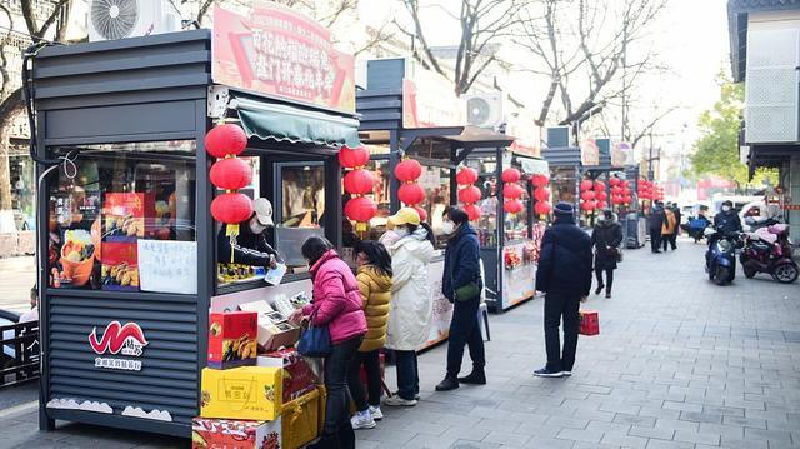China and Covid19
Foxconn Protests 2.0: Riots at Zhengzhou’s Foxconn Factory as New Workers Enter and Old Problems Remain
Fed up with Foxconn, employees vented their frustrations and started a riot at the Zhengzhou factory campus.
Published
2 years agoon
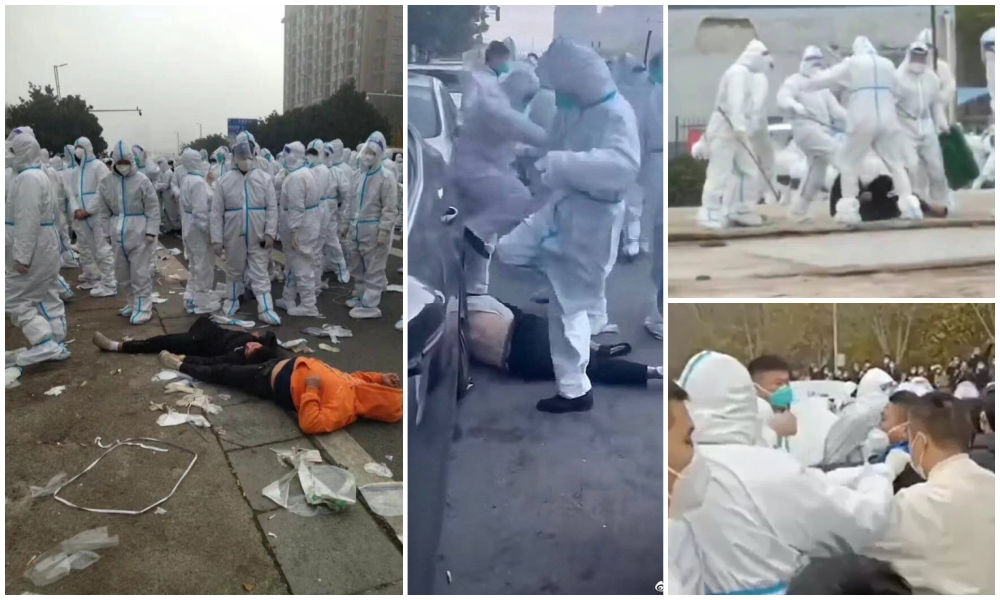
WHAT’S ON WEIBO ARCHIVE | PREMIUM CONTENT ARTICLE
Following an exodus of employees, Zhengzhou’s Foxconn factory has been recruiting thousands of new employees to come and work for them. But despite new workers, old problems remain, and the “Foxconn Workers Movement 2.0” (富士康2.0工人运动) has begun.
There is trouble in Foxconn, again. Dealing with a Covid outbreak, anti-epidemic guidelines, a loss of employees, and the pressure to deliver at a time of peak production demand, the anger, panic, and frustrations have been mounting inside the Foxconn premises.
In late October, Foxconn (富士康), the world’s largest technology manufacturer and Apple supplier, already made headlines after its factory in Zhengzhou, Henan, was hit by a Covid outbreak that was grossly mismanaged. The Foxconn complex in Zhengzhou, where half of the world’s iPhones are made, employs approximately 300,000 people. Factory workers live at the Foxconn dormitories and usually eat inside the campus, but as living conditions worsened amid the wave of Covid cases, employees started fleeing the Foxconn ‘factory city,’ starting their long journey home on foot, walking on highways and fields across the Central Plains while carrying their blankets, bags, and other personal belongings.

Foxconn employees leaving the bad situation at the factory campus and going home by foot in late October of 2022.
After the big walk-out, the company dealt with a staff shortage so local government staff teams were called in, allegedly to get into the factory and help with the recruitment of new employees. But as they faced challenges in meeting their targets and attracting enough new workers and did not meet their targets, frustrations at the factory site were allegedly building up due to the increased pressure on the employees who had to continue working while Covid cases were still popping up.
Videos circulating on social media show riots and unrest at Zhengzhou Foxconn, where workers are fed up working during a mismanaged Covid outbreak and feel cheated by the company. As the topic is restricted on Weibo, some wonder if they were shooting a movie there.. pic.twitter.com/CCPI3y2ICR
— Manya Koetse (@manyapan) November 23, 2022
As rumors grew strong on Chinese social media about something happening at Foxconn in Zhengzhou in the early morning of 23 November, the majority of posts related to the issue are: “What happened?” and “Can anybody send me a private message on what happened?” “Is it true that they are filming a movie at Foxconn or is something else going on?” Due to censorship, many people did not understand the exact circumstances surrounding some of the videos that circulated online.
Censorship and self-censorship makes it hard to find out exactly what's going on. When one commenter asked what is happening here, the other replied: "They're watching the World Cup, cheering on the Japanese team" ("看世界杯,给小日本加油呢.") pic.twitter.com/p15XaI9aVC
— Manya Koetse (@manyapan) November 23, 2022
Meanwhile, posts circulating on WeChat and Douyin suggested that riots had erupted at Foxconn. Photos and videos making their rounds showed explosive and violent scenes involving police riot teams and people in full hazmat suits. The unrest continued during the day on Wednesday.
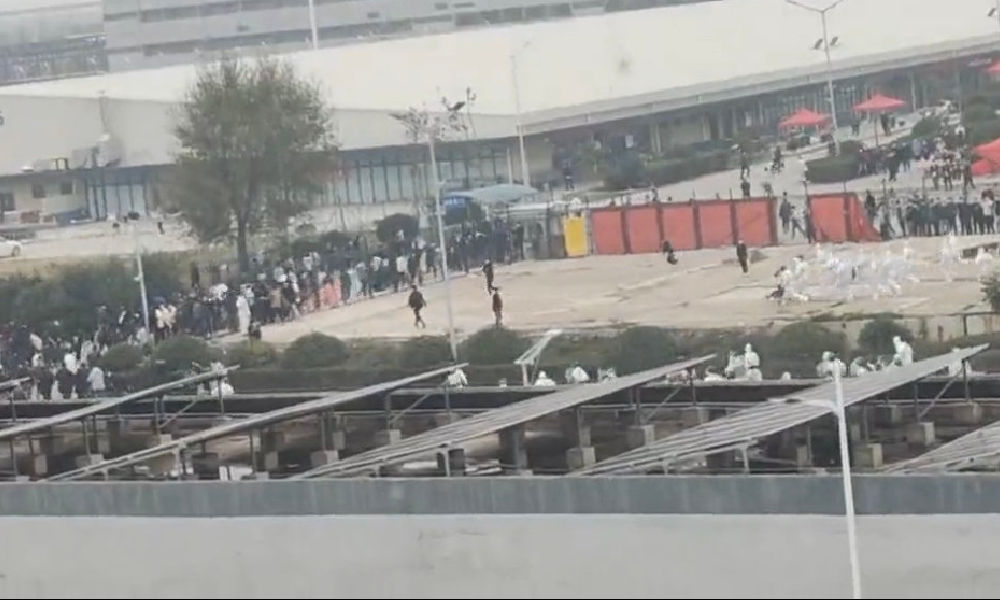
One post published by an anonymous Henan-based Douyin user explained:
“Let me tell you what happened at Foxconn today. Foxconn has recruited people from all over the country to come work in Zhengzhou Foxconn under generous conditions. Now in total more than 100,000 people have been recruited to come work at Zhengzhou Foxconn. They came over and were quarantined in the cities near Zhengzhou to isolate and quarantine for four days while getting paid.”
“But the problem now is that the first batch of people who have isolated have arrived at the Foxconn campus as new workers. Foxconn originally promised that new workers and original workers would live separately, but in reality they all live in the dorm buildings; and the old employees haven’t done nucleic acid testing for 7-8 days, which means that there are positive Covid cases living and working together with new employees. This caused panic among the new workers, who feel cheated. That was the first deception.”
“The second deception is that tonight everybody received a new contract from Foxconn, regardless if they were new employees who had already entered the Foxconn campus or employees who were still in quarantine, and the contract was totally different from the one issued by Foxconn at the time of recruitment.”
“Everyone felt that Foxconn has deceived from the start and tricked them, which led to the outburst of riots today. Up to now, the Zhengzhou government has not given any response and we do not know how this will develop.”
It is suggested in other videos that the problems at Foxconn had been building up for much longer now and that there have been smaller altercations and incidents in the days leading up to the outburst of protests on Wednesday.
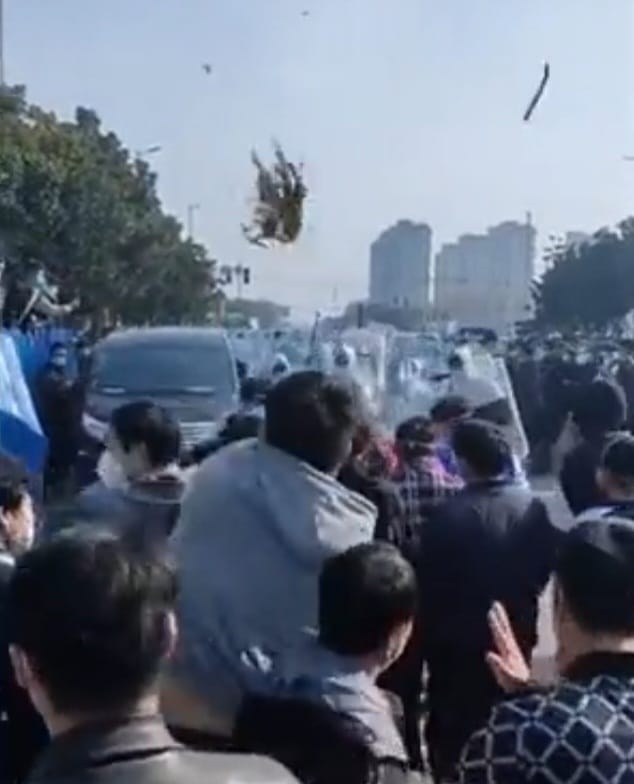
Some news sources confirm that Foxconn workers stated to reporters that the company introduced new factory subsidy policies that were not in line with what they were promised at the time of recruitment.
Because this is the second big wave of unrest at Foxconn Zhengzhou this fall, allegedly mainly led by the new workers, the protest is also referred to as the “Foxconn Workers Movement 2.0” (富士康2.0工人运动) by some on social media.
“We are not asking for anything, just regular nucleic acid testing and food delivery would do,” one female said in a video that circulated on Kuaishou, another popular Chinese social video app.
“Foxconn is trash, they’re garbage, they’ve used military force to suppress the workers, many staff members got injured, and the Zhengzhou government is colluding with them in bullying ordinary workers,” one Weibo commenter wrote.
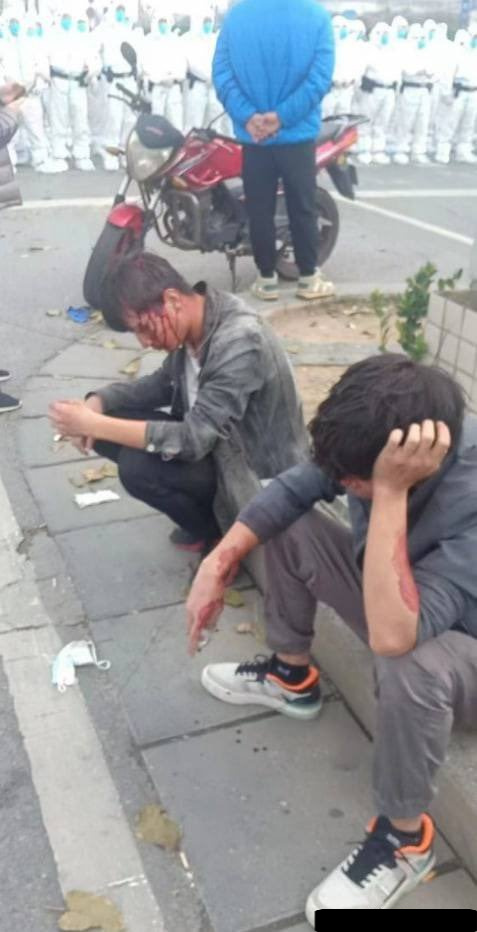
Two men look defeated at the Foxconn site, the hazmat suits in the back lined up like a brick wall.
“I feel so sorry for the workers.”
There are also those on Weibo who are drawing comparisons between protests at Foxconn and the Hong Kong riots: “I find it odd that once riots broke out in Hong Kong, everyone unanimously sided with the police and cheered on as they beat the ‘cockroaches,’ and now that riots are breaking out in Foxconn, people don’t even take the time to know the cause and effects before already blaming the police and the government.”
“We should support mainland China police in the same way we supported the Hong Kong police force,” others wrote.
Meanwhile, a clear majority of the people speak out in support of the Foxconn workers. They post old propaganda posters that emphasize how the Chinese working class will lead the revolution, and recommend other Weibo users to read Karl Marx. “Is the working class still leading?” they ask.
Noteworthy enough, one somewhat popular post on Weibo pointed out that the online censorship of the Foxconn protests had not been that bad as many videos and images surrounding the event were still circulating online. “That’s rare these days,” they wrote. Ironically, the image they posted with their text was censored.
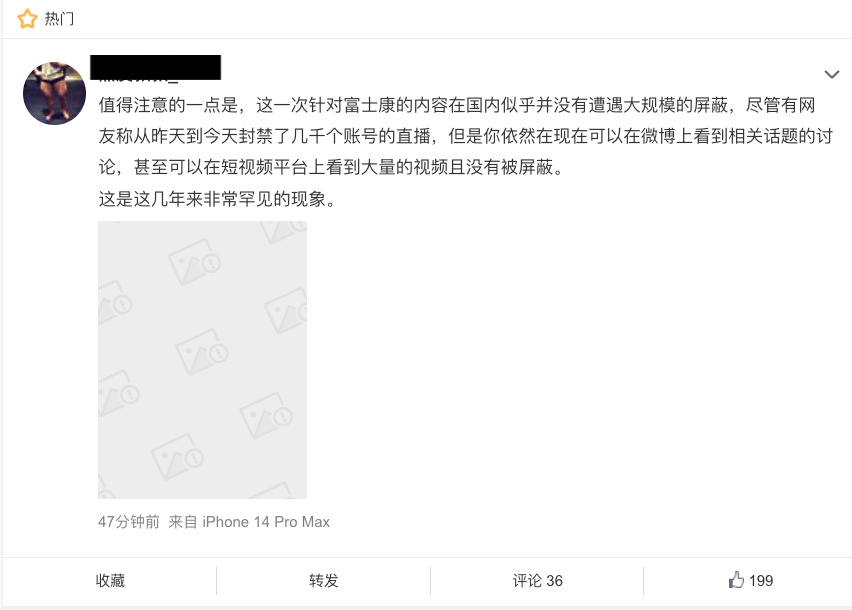
It is now frequently pointed out that Zhengzhou is ruining its reputation. Although the entire country cheered for the city at the time of the floods in 2021, local authorities have been increasingly criticized since the duped depositors came to protest in the city and saw their health codes turn red. People also condemn Zhengzhou’s handling of the epidemic. Earlier this week, a local community went viral for warning outsiders that they would ‘be killed on the spot’ if they would enter; last week, a local initiative to launch extra expensive, extra fast ‘VIP services’ for nucleic acid testing was also met with disapproval.
“I feel so distressed about this,” one Weibo commenter replied to the Foxconn situation: “It’s time to wake up!”
“What’s the first sentence of the national anthem?” one blogger wrote: “Stand up, those who refuse to be slaves!”
For more articles on the Covid situation in China, check here. If you appreciate what we do, please support us by subscribing for just a small annual fee.
By Manya Koetse , with contributions by Miranda Barnes
Get the story behind the hashtag. Subscribe to What’s on Weibo here to receive our newsletter and get access to our latest articles:
Spotted a mistake or want to add something? Please let us know in comments below or email us. First-time commenters, please be patient – we will have to manually approve your comment before it appears.
©2022 Whatsonweibo. All rights reserved. Do not reproduce our content without permission – you can contact us at info@whatsonweibo.com.
Manya Koetse is the founder and editor-in-chief of whatsonweibo.com. She is a writer, public speaker, and researcher (Sinologist, MPhil) on social trends, digital developments, and new media in an ever-changing China, with a focus on Chinese society, pop culture, and gender issues. She shares her love for hotpot on hotpotambassador.com. Contact at manya@whatsonweibo.com, or follow on Twitter.

China and Covid19
Sick Kids, Worried Parents, Overcrowded Hospitals: China’s Peak Flu Season on the Way
“Besides Mycoplasma infections, cases include influenza, Covid-19, Norovirus, and Adenovirus. Heading straight to the hospital could mean entering a cesspool of viruses.”
Published
8 months agoon
November 22, 2023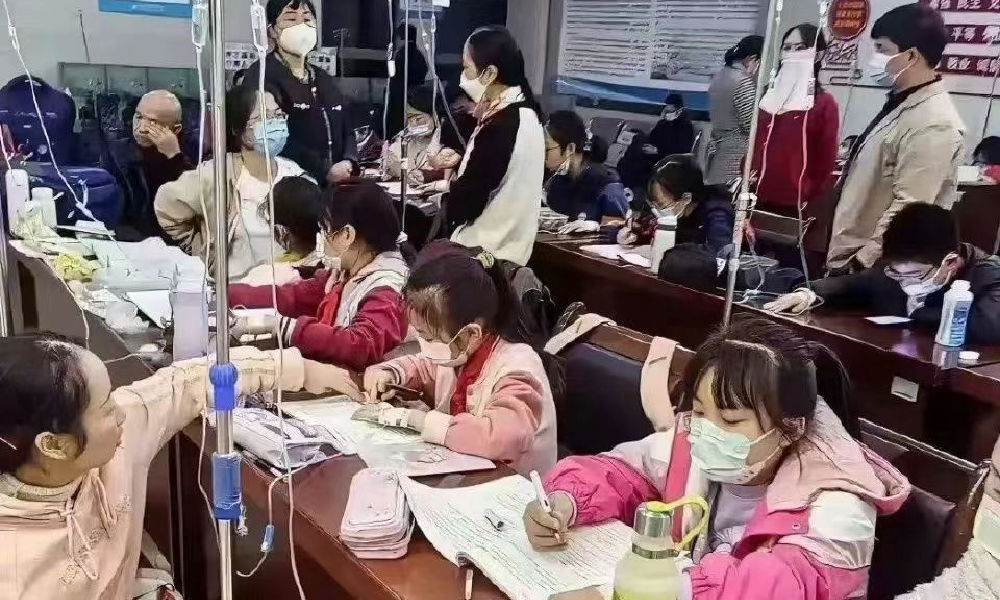
In the early morning of November 21, parents are already queuing up at Xi’an Children’s Hospital with their sons and daughters. It’s not even the line for a doctor’s appointment, but rather for the removal of IV needles.
The scene was captured in a recent video, only one among many videos and images that have been making their rounds on Chinese social media these days (#凌晨的儿童医院拔针也要排队#).
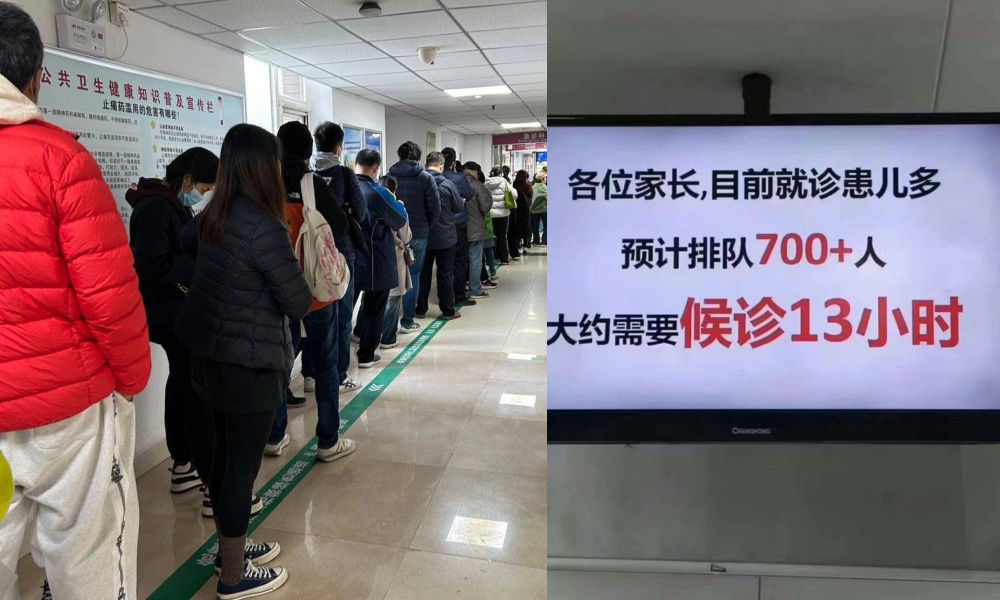
One photo shows a bulletin board at a local hospital warning parents that over 700 patients are waiting in line, estimating a waiting time of more than 13 hours to see a doctor.
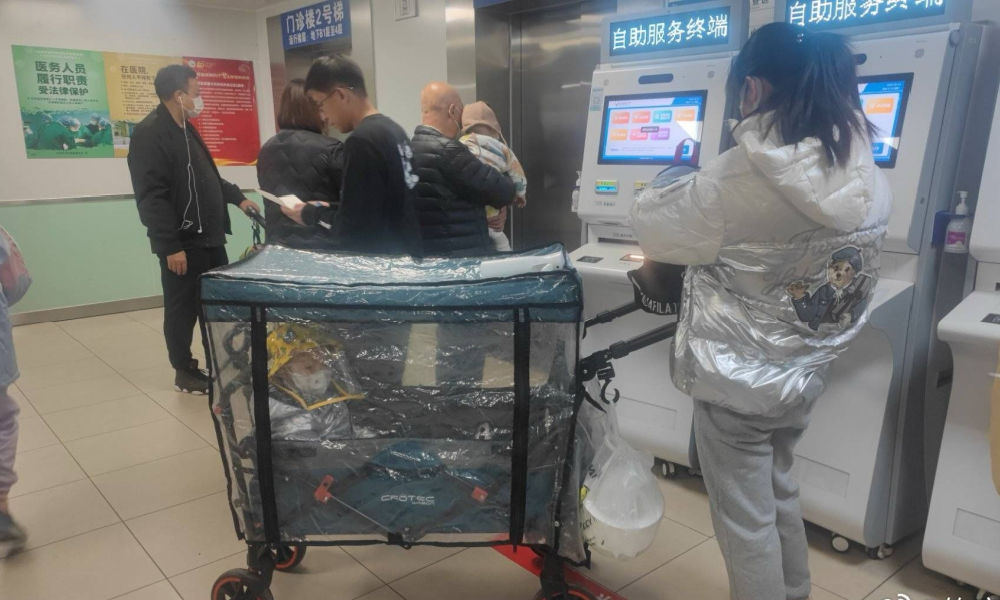
Another image shows children doing their homework while hooked up on an IV.
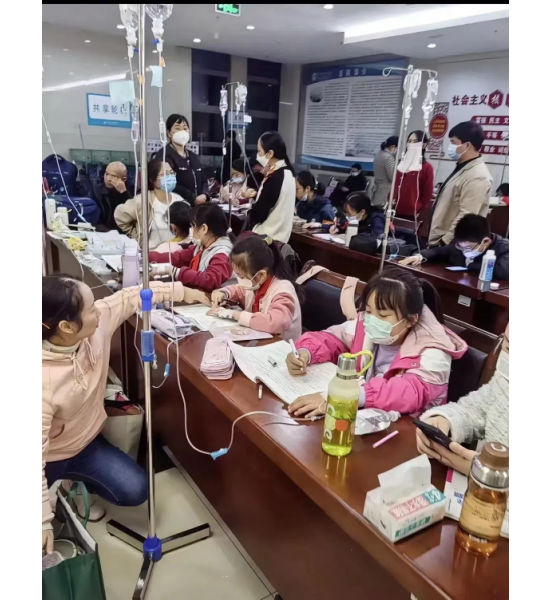
Recent discussions on Chinese social media platforms have highlighted a notable surge in flu cases. The ongoing flu season is particularly impacting children, with multiple viruses concurrently circulating and contributing to a high incidence of respiratory infections.
Among the prevalent respiratory infections affecting children are Mycoplasma pneumoniae infections, influenza, and Adenovirus infection.
The spike in flu cases has resulted in overcrowded children’s hospitals in Beijing and other Chinese cities. Parents sometimes have to wait in line for hours to get an appointment or pick up medication.
According to one reporter at Haibao News (海报新闻), there were so many patients at the Children’s Hospital of Capital Institute of Pediatrics (首都儿科研究所) on November 21st that the outpatient desk stopped accepting new patients by the afternoon. Meanwhile, 628 people were waiting in line to see a doctor at the emergency department.
Reflecting on the past few years, the current flu season marks China’s first ‘normal’ flu peak season since the outbreak of Covid-19 in late 2019 / early 2020 and the end of its stringent zero-Covid policies in December 2022. Compared to many other countries, wearing masks was also commonplace for much longer following the relaxation of Covid policies.
Hu Xijin, the well-known political commentator, noted on Weibo that this year’s flu season seems to be far worse than that of the years before. He also shared that his own granddaughter was suffering from a 40 degrees fever.
“We’re all running a fever in our home. But I didn’t dare to go to the hospital today, although I want my child to go to the hospital tomorrow. I heard waiting times are up to five hours now,” one Weibo user wrote.
“Half of the kids in my child’s class are sick now. The hospital is overflowing with people,” another person commented.
One mother described how her 7-year-old child had been running a fever for eight days already. Seeking medical attention on the first day, the initial diagnosis was a cold. As the fever persisted, daily visits to the hospital ensued, involving multiple hours for IV fluid administration.
While this account stems from a single Weibo post within a fever-advice community, it highlights a broader trend: many parents swiftly resort to hospital visits at the first signs of flu or fever. Several factors contribute to this, including a lack of General Practitioners in China, making hospitals the primary choice for medical consultations also in non-urgent cases.
There is also a strong belief in the efficacy of IV infusion therapy, whether fluid-based or containing medication, as the quickest path to recovery. Multiple factors contribute to the widespread and sometimes irrational use of IV infusions in China. Some clinics are profit-driven and see IV infusions as a way to make more money. Widespread expectations among Chinese patients that IV infusions will make them feel better also play a role, along with some physicians’ lacking knowledge of IV therapy or their uncertainty to distinguish bacterial from viral infections (read more here)
To prevent an overwhelming influx of patients to hospitals, Chinese state media, citing specialists, advise parents to seek medical attention at the hospital only for sick infants under three months old displaying clear signs of fever (with or without cough). For older children, it is recommended to consult a doctor if a high fever persists for 3 to 5 days or if there is a deterioration in respiratory symptoms. Children dealing with fever and (mild) respiratory symptoms can otherwise recover at home.
One Weibo blogger (@奶霸知道) warned parents that taking their child straight to the hospital on the first day of them getting sick could actually be a bad idea. They write:
“(..) pediatric departments are already packed with patients, and it’s not just Mycoplasma infections anymore. Cases include influenza, Covid-19, Norovirus, and Adenovirus. And then, of course, those with bad luck are cross-infected with multiple viruses at the same time, leading to endless cycles. Therefore, if your child experiences mild coughing or a slight fever, consider observing at home first. Heading straight to the hospital could mean entering a cesspool of viruses.”
The hashtag for “fever” saw over 350 million clicks on Weibo within one day on November 22.
Meanwhile, there are also other ongoing discussions on Weibo surrounding the current flu season. One topic revolves around whether children should continue doing their homework while receiving IV fluids in the hospital. Some hospitals have designated special desks and study areas for children.
Although some commenters commend the hospitals for being so considerate, others also remind the parents not to pressure their kids too much and to let them rest when they are not feeling well.
Opinions vary: although some on Chinese social media say it's very thoughtful for hospitals to set up areas where kids can study and read, others blame parents for pressuring their kids to do homework at the hospital instead of resting when not feeling well. pic.twitter.com/gnQD9tFW2c
— Manya Koetse (@manyapan) November 22, 2023
By Manya Koetse, with contributions from Miranda Barnes
Get the story behind the hashtag. Subscribe to What’s on Weibo here to receive our newsletter and get access to our latest articles:
Spotted a mistake or want to add something? Please let us know in comments below or email us. First-time commenters, please be patient – we will have to manually approve your comment before it appears.
©2023 Whatsonweibo. All rights reserved. Do not reproduce our content without permission – you can contact us at info@whatsonweibo.com.
China and Covid19
Repurposing China’s Abandoned Nucleic Acid Booths: 10 Innovative Transformations
Abandoned nucleic acid booths are getting a second life through these new initiatives.
Published
1 year agoon
May 19, 2023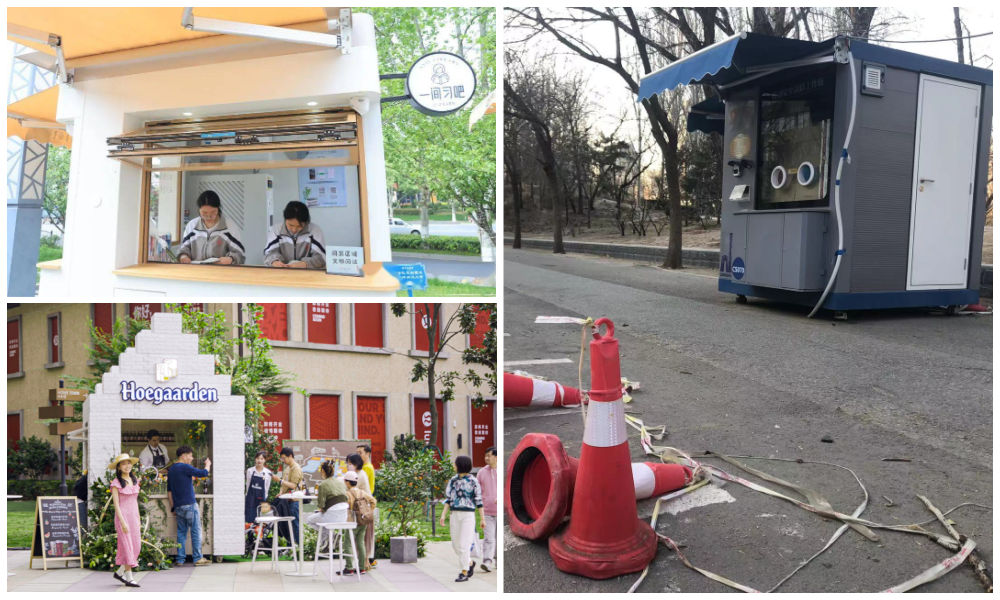
During the pandemic, nucleic acid testing booths in Chinese cities were primarily focused on maintaining physical distance. Now, empty booths are being repurposed to bring people together, serving as new spaces to serve the community and promote social engagement.
Just months ago, nucleic acid testing booths were the most lively spots of some Chinese cities. During the 2022 Shanghai summer, for example, there were massive queues in front of the city’s nucleic acid booths, as people needed a negative PCR test no older than 72 hours for accessing public transport, going to work, or visiting markets and malls.
The word ‘hésuān tíng‘ (核酸亭), nucleic acid booth (also:核酸采样小屋), became a part of China’s pandemic lexicon, just like hésuān dìtú (核酸地图), the nucleic acid test map lauched in May 2022 that would show where you can get a nucleic test.
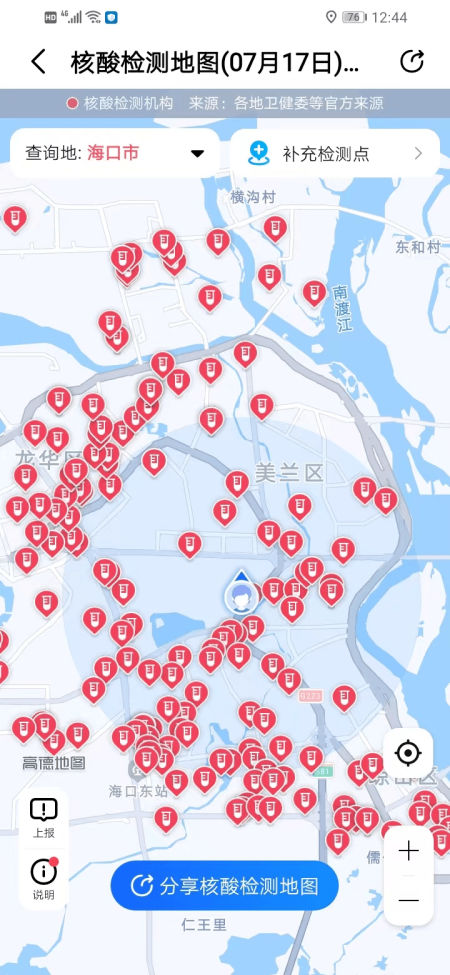
Example of nucleic acid test map.
During Halloween parties in Shanghai in 2022, some people even came dressed up as nucleic test booths – although local authorities could not appreciate the creative costume.
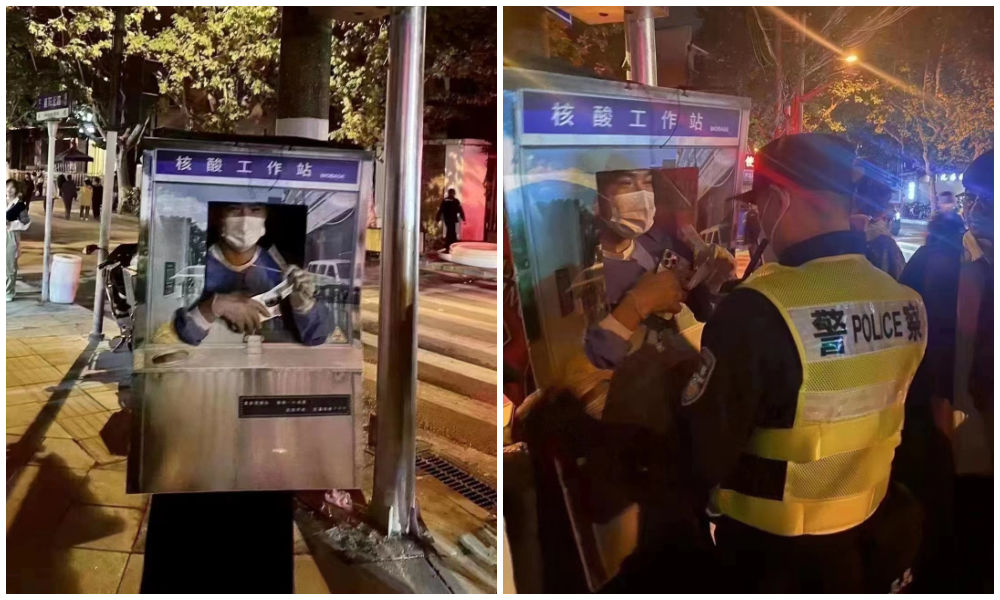
Halloween 2022: dressed up as nucliec acid booths. Via @manyapan twitter.
In December 2022, along with the announced changed rules in China’s ‘zero Covid’ approach, nucleic acid booths were suddenly left dismantled and empty.
With many cities spending millions to set up these booths in central locations, the question soon arose: what should they do with the abandoned booths?
This question also relates to who actually owns them, since the ownership is mixed. Some booths were purchased by authorities, others were bought by companies, and there are also local communities owning their own testing booths. Depending on the contracts and legal implications, not all booths are able to get a new function or be removed yet (Worker’s Daily).
In Tianjin, a total of 266 nucleic acid booths located in Jinghai District were listed for public acquisition earlier this month, and they were acquired for 4.78 million yuan (US$683.300) by a local food and beverage company which will transform the booths into convenience service points, selling snacks or providing other services.
Tianjin is not the only city where old nucleic acid testing booths are being repurposed. While some booths have been discarded, some companies and/or local governments – in cooperation with local communities – have demonstrated creativity by transforming the booths into new landmarks. Since the start of 2023, different cities and districts across China have already begun to repurpose testing booths. Here, we will explore ten different way in which China’s abandoned nucleic test booths get a second chance at a meaningful existence.
1: Pharmacy/Medical Booths
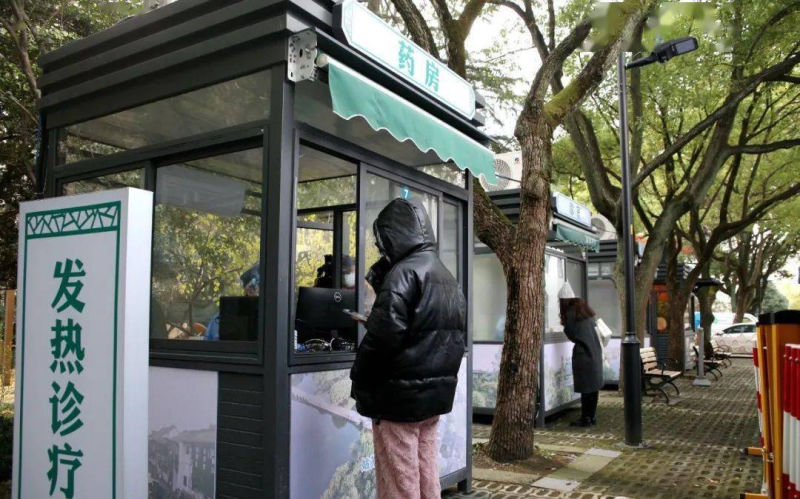
Via ‘copyquan’ republished on Sohu.
Blogger ‘copyquan’ recently explored various ways in which abandoned PCR testing points are being repurposed.
One way in which they are used is as small pharmacies or as medical service points for local residents (居民医疗点). Alleviating the strain on hospitals and pharmacies, this was one of the earliest ways in which the booths were repurposed back in December of 2022 and January of 2023.
Chongqing, Tianjin, and Suzhou were among earlier cities where some testing booths were transformed into convenient medical facilities.
2: Market Stalls
In Suzhou, Jiangsu province, the local government transformed vacant nucleic acid booths into market stalls for the Spring Festival in January 2022, offering them free of charge to businesses to sell local products, snacks, and traditional New Year goods.
The idea was not just meant as a way for small businesses to conveniently sell to local residents, it was also meant as a way to attract more shoppers and promote other businesses in the neighborhood.
3: Community Service Center
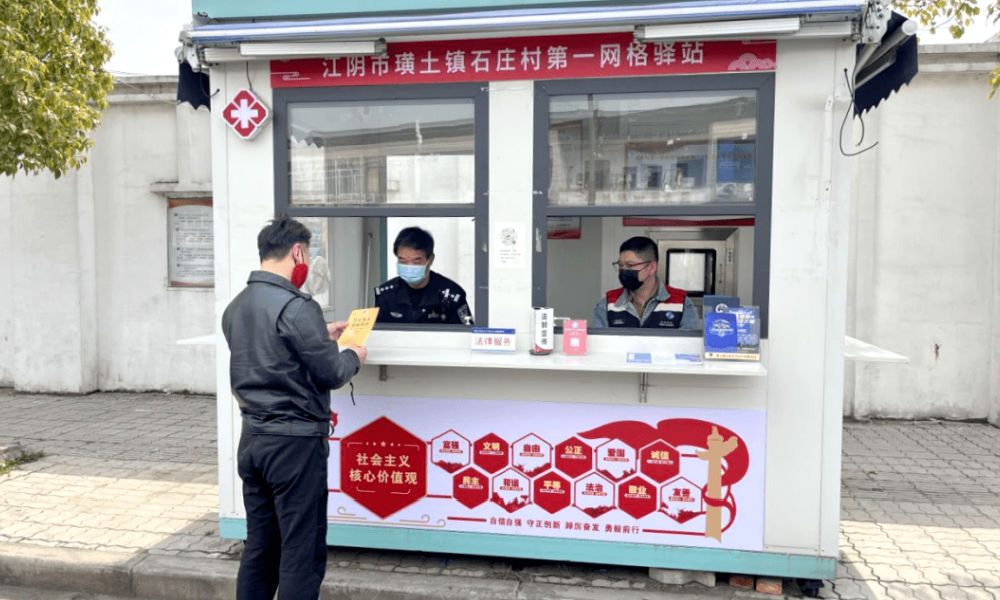
Small grid community center in Shizhuang Village, image via Sohu.
Some residential areas have transformed their local nucleic acid testing booths into community service centers, offering all kinds of convenient services to neighborhood residents.
These little station are called wǎnggé yìzhàn (网格驿站) or “grid service stations,” and they can serve as small community centers where residents can get various kinds of care and support.
4: “Refuel” Stations
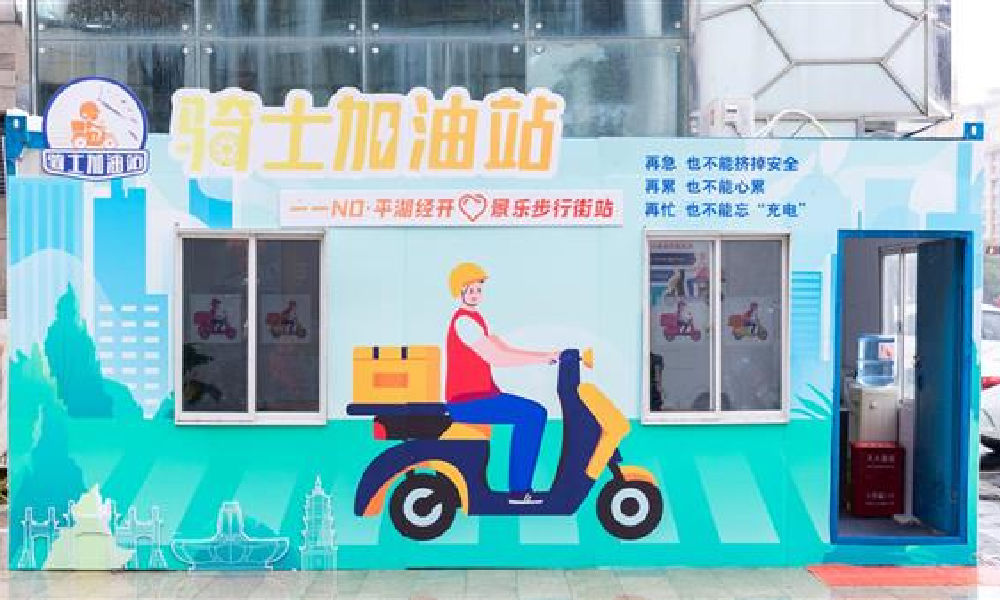
In February of this year, 100 idle nucleic acid sampling booths were transformed into so-called “Rider Refuel Stations” (骑士加油站) in Zhejiang’s Pinghu. Although it initially sounds like a place where delivery riders can fill up their fuel tanks, it is actually meant as a place where they themselves can recharge.
Delivery riders and other outdoor workers can come to the ‘refuel’ station to drink some water or tea, warm their hands, warm up some food and take a quick nap.
5: Free Libraries
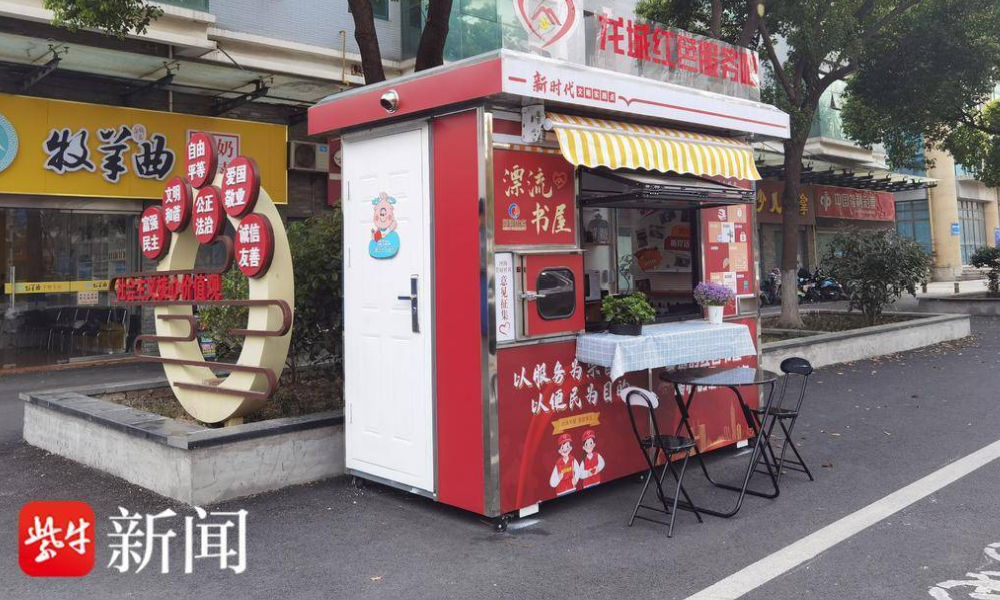
image via sohu.
In various Chinese cities, abandoned nucleic acid booths have been transformed into little free libraries where people can grab some books to read, donate or return other books, and sit down for some reading.
Changzhou is one of the places where you’ll find such “drifting bookstores” (漂流书屋) (see video), but similar initiatives have also been launched in other places, including Suzhou.
6: Study Space
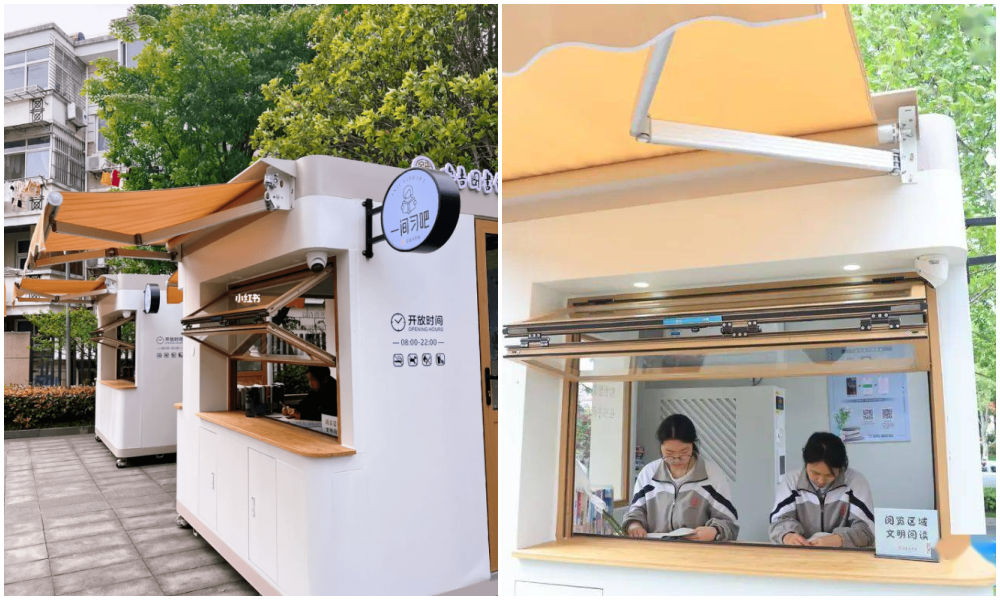
Photos via Copyquan’s article on Sohu.
Another innovative way in which old testing points are being repurposed is by turning them into places where students can sit together to study. The so-called “Let’s Study Space” (一间习吧), fully airconditioned, are opened from 8 in the morning until 22:00 at night.
Students – or any citizens who would like a nice place to study – can make online reservations with their ID cards and scan a QR code to enter the study rooms.
There are currently ten study booths in Anji, and the popular project is an initiative by the Anji County Library in Zhejiang (see video).
7: Beer Kiosk
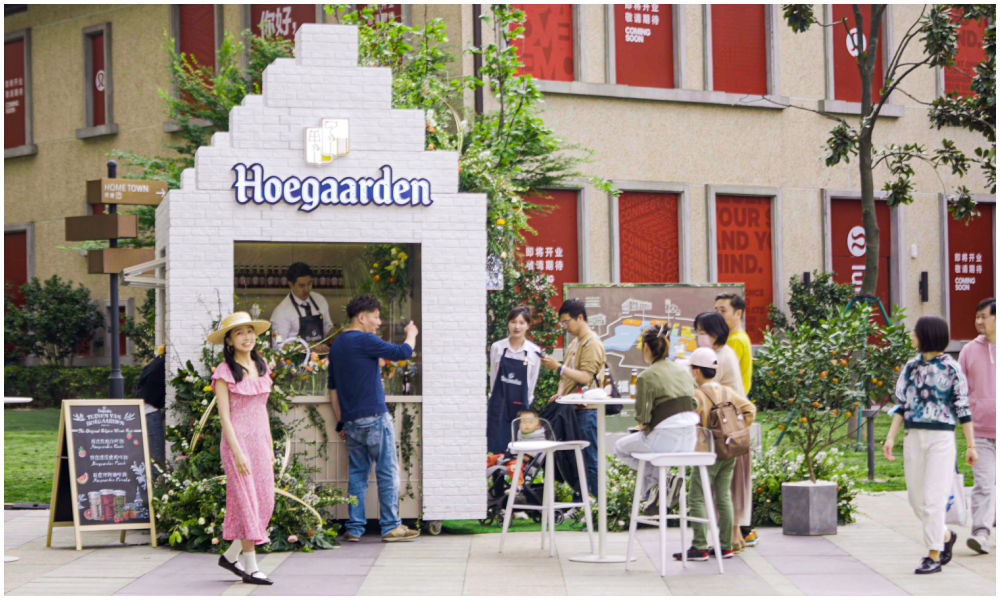
Hoegaarden beer shop, image via Creative Adquan.
Changing an old nucleic acid testing booth into a beer bar is a marketing initiative by the Shanghai McCann ad agency for the Belgium beer brand Hoegaarden.
The idea behind the bar is to celebrate a new spring after the pandemic. The ad agency has revamped a total of six formr nucleic acid booths into small Hoegaarden ‘beer gardens.’
8: Police Box

In Taizhou City, Jiangsu Province, authorities have repurposed old testing booths and transformed them into ‘police boxes’ (警务岗亭) to enhance security and improve the visibility of city police among the public.
Currently, a total of eight vacant nucleic acid booths have been renovated into modern police stations, serving as key points for police presence and interaction with the community.
9: Lottery Ticket Booths
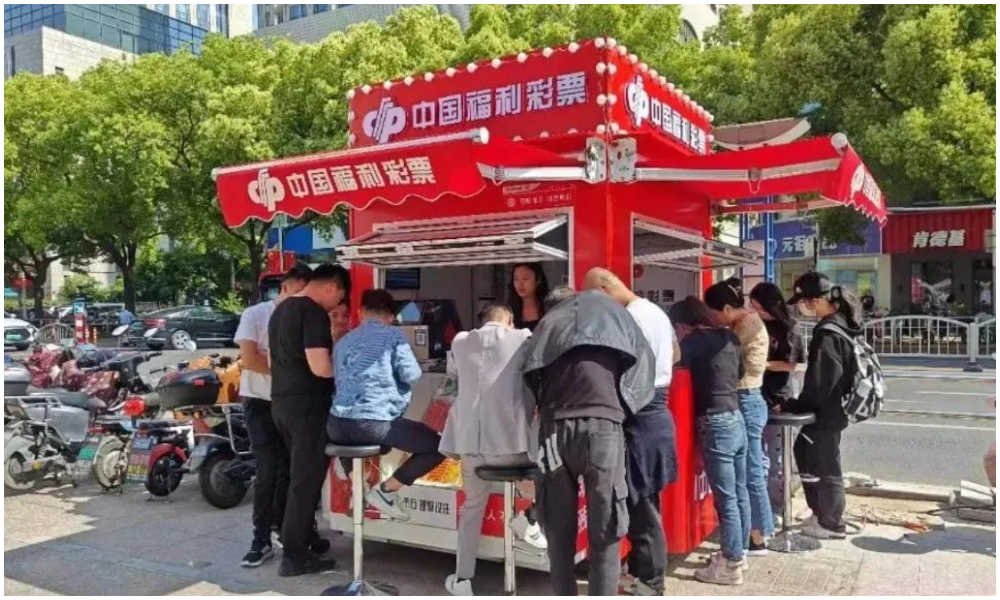
Image via The Paper
Some nucleic acid booths have now been turned into small shops selling lottery tickets for the China Welfare Lottery. One such place turning the kiosks into lottery shops is Songjiang in Shanghai.
Using the booths like this is a win-win situation: they are placed in central locations so it is more convenient for locals to get their lottery tickets, and on the other hand, the sales also help the community, as the profits are used for welfare projects, including care for the elderly.
10: Mini Fire Stations
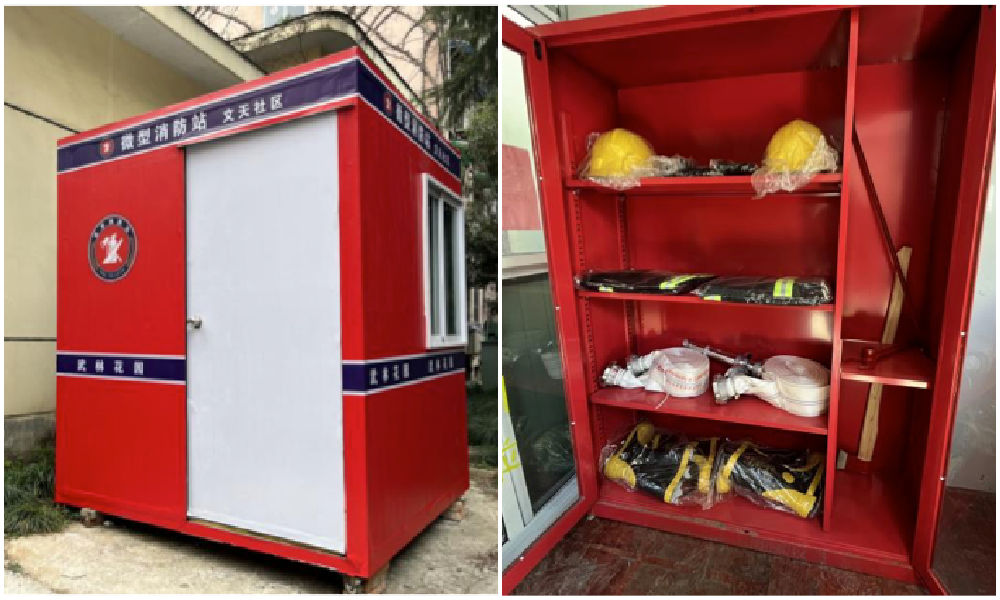
Micro fire stations, images via ZjNews.
Some communities decided that it would be useful to repurpose the testing points and turn them into mini fire kiosks, just allowing enough space for the necessary equipment to quickly respond to fire emergencies.
Want to read more about the end of ‘zero Covid’ in China? Check our other articles here.
By Manya Koetse,
Get the story behind the hashtag. Subscribe to What’s on Weibo here to receive our newsletter and get access to our latest articles:
Spotted a mistake or want to add something? Please let us know in comments below or email us. First-time commenters, please be patient – we will have to manually approve your comment before it appears.
©2023 Whatsonweibo. All rights reserved. Do not reproduce our content without permission – you can contact us at info@whatsonweibo.com.
Subscribe

Weibo Watch: The Future is Here

“Bye Bye Biden”: Biden’s Many Nicknames in Chinese

Enjoying the ‘Sea’ in Beijing’s Ditan Park

A Triumph for “Comrade Trump”: Chinese Social Media Reactions to Trump Rally Shooting

Weibo Watch: Get Up, Stand Up

The Tragic Story of “Fat Cat”: How a Chinese Gamer’s Suicide Went Viral

“Old Bull Eating Young Grass”: 86-Year-Old Chinese Painter Fan Zeng Marries 36-Year-Old Xu Meng

A Brew of Controversy: Lu Xun and LELECHA’s ‘Smoky’ Oolong Tea

Singing Competition or Patriotic Fight? Hunan TV’s ‘Singer 2024’ Stirs Nationalistic Sentiments

Zara Dress Goes Viral in China for Resemblance to Haidilao Apron

Weibo Watch: The Battle for the Bottom Bed

About the “AI Chatbot Based on Xi Jinping” Story

China’s Intensified Social Media Propaganda: “Taiwan Must Return to Motherland”

Weibo Watch: Telling China’s Stories Wrong

Saying Goodbye to “Uncle Wang”: Wang Wenbin Becomes Chinese Ambassador to Cambodia
Get in touch
Would you like to become a contributor, or do you have any tips or suggestions? Get in touch here!
Popular Reads
-

 China Insight3 months ago
China Insight3 months agoThe Tragic Story of “Fat Cat”: How a Chinese Gamer’s Suicide Went Viral
-

 China Music4 months ago
China Music4 months agoThe Chinese Viral TikTok Song Explained (No, It’s Not About Samsung)
-

 China Digital10 months ago
China Digital10 months agoToo Sexy for Weibo? Online Discussions on the Concept of ‘Cābiān’
-

 China Arts & Entertainment12 months ago
China Arts & Entertainment12 months agoBehind 8 Billion Streams: Who is Dao Lang Cursing in the Chinese Hit Song ‘Luocha Kingdom’?






